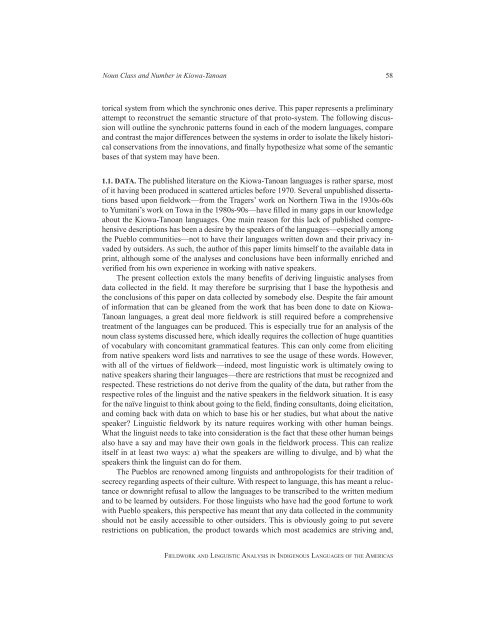Fieldwork and Linguistic Analysis in Indigenous ... - ScholarSpace
Fieldwork and Linguistic Analysis in Indigenous ... - ScholarSpace
Fieldwork and Linguistic Analysis in Indigenous ... - ScholarSpace
Create successful ePaper yourself
Turn your PDF publications into a flip-book with our unique Google optimized e-Paper software.
Noun Class <strong>and</strong> Number <strong>in</strong> Kiowa-Tanoan 58<br />
torical system from which the synchronic ones derive. This paper represents a prelim<strong>in</strong>ary<br />
attempt to reconstruct the semantic structure of that proto-system. The follow<strong>in</strong>g discussion<br />
will outl<strong>in</strong>e the synchronic patterns found <strong>in</strong> each of the modern languages, compare<br />
<strong>and</strong> contrast the major differences between the systems <strong>in</strong> order to isolate the likely historical<br />
conservations from the <strong>in</strong>novations, <strong>and</strong> f<strong>in</strong>ally hypothesize what some of the semantic<br />
bases of that system may have been.<br />
1.1. DATA. The published literature on the Kiowa-Tanoan languages is rather sparse, most<br />
of it hav<strong>in</strong>g been produced <strong>in</strong> scattered articles before 1970. Several unpublished dissertations<br />
based upon fieldwork—from the Tragers’ work on Northern Tiwa <strong>in</strong> the 1930s-60s<br />
to Yumitani’s work on Towa <strong>in</strong> the 1980s-90s—have filled <strong>in</strong> many gaps <strong>in</strong> our knowledge<br />
about the Kiowa-Tanoan languages. One ma<strong>in</strong> reason for this lack of published comprehensive<br />
descriptions has been a desire by the speakers of the languages—especially among<br />
the Pueblo communities—not to have their languages written down <strong>and</strong> their privacy <strong>in</strong>vaded<br />
by outsiders. As such, the author of this paper limits himself to the available data <strong>in</strong><br />
pr<strong>in</strong>t, although some of the analyses <strong>and</strong> conclusions have been <strong>in</strong>formally enriched <strong>and</strong><br />
verified from his own experience <strong>in</strong> work<strong>in</strong>g with native speakers.<br />
The present collection extols the many benefits of deriv<strong>in</strong>g l<strong>in</strong>guistic analyses from<br />
data collected <strong>in</strong> the field. It may therefore be surpris<strong>in</strong>g that I base the hypothesis <strong>and</strong><br />
the conclusions of this paper on data collected by somebody else. Despite the fair amount<br />
of <strong>in</strong>formation that can be gleaned from the work that has been done to date on Kiowa-<br />
Tanoan languages, a great deal more fieldwork is still required before a comprehensive<br />
treatment of the languages can be produced. This is especially true for an analysis of the<br />
noun class systems discussed here, which ideally requires the collection of huge quantities<br />
of vocabulary with concomitant grammatical features. This can only come from elicit<strong>in</strong>g<br />
from native speakers word lists <strong>and</strong> narratives to see the usage of these words. However,<br />
with all of the virtues of fieldwork—<strong>in</strong>deed, most l<strong>in</strong>guistic work is ultimately ow<strong>in</strong>g to<br />
native speakers shar<strong>in</strong>g their languages—there are restrictions that must be recognized <strong>and</strong><br />
respected. These restrictions do not derive from the quality of the data, but rather from the<br />
respective roles of the l<strong>in</strong>guist <strong>and</strong> the native speakers <strong>in</strong> the fieldwork situation. It is easy<br />
for the naïve l<strong>in</strong>guist to th<strong>in</strong>k about go<strong>in</strong>g to the field, f<strong>in</strong>d<strong>in</strong>g consultants, do<strong>in</strong>g elicitation,<br />
<strong>and</strong> com<strong>in</strong>g back with data on which to base his or her studies, but what about the native<br />
speaker? <strong>L<strong>in</strong>guistic</strong> fieldwork by its nature requires work<strong>in</strong>g with other human be<strong>in</strong>gs.<br />
What the l<strong>in</strong>guist needs to take <strong>in</strong>to consideration is the fact that these other human be<strong>in</strong>gs<br />
also have a say <strong>and</strong> may have their own goals <strong>in</strong> the fieldwork process. This can realize<br />
itself <strong>in</strong> at least two ways: a) what the speakers are will<strong>in</strong>g to divulge, <strong>and</strong> b) what the<br />
speakers th<strong>in</strong>k the l<strong>in</strong>guist can do for them.<br />
The Pueblos are renowned among l<strong>in</strong>guists <strong>and</strong> anthropologists for their tradition of<br />
secrecy regard<strong>in</strong>g aspects of their culture. With respect to language, this has meant a reluctance<br />
or downright refusal to allow the languages to be transcribed to the written medium<br />
<strong>and</strong> to be learned by outsiders. For those l<strong>in</strong>guists who have had the good fortune to work<br />
with Pueblo speakers, this perspective has meant that any data collected <strong>in</strong> the community<br />
should not be easily accessible to other outsiders. This is obviously go<strong>in</strong>g to put severe<br />
restrictions on publication, the product towards which most academics are striv<strong>in</strong>g <strong>and</strong>,<br />
fieldwork <strong>and</strong> l<strong>in</strong>guistic analysis <strong>in</strong> <strong>in</strong>digenous languages of the americas

















